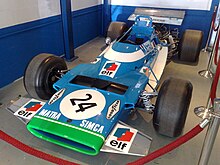Chris Amon
Born and raised in Bulls, Amon learned to drive aged six and initially competed in hillclimbing before progressing to national motor racing competition in 1962.
Amon was renowned for his poor luck in Formula One, losing out on several World Championship race wins due to mechanical faults.
Across 14 seasons, he achieved five pole positions, three fastest laps and 11 podiums, with two non-championship wins at the 1970 BRDC International Trophy and the 1971 Argentine Grand Prix.
Amon was appointed a Member of the Order of the British Empire in the 1993 Queen's Birthday Honours, and inducted into the New Zealand Sports Hall of Fame in 1995.
[6] On leaving school, he persuaded his father to buy him an Austin A40 Special, which he entered in some minor local races and hillclimbs along with practice on the family farm.
[7] He progressed to a 1.5-litre Cooper and then an old 2.5-litre Maserati 250F, but only began to draw attention when he drove the Cooper-Climax T51 which Bruce McLaren had used to win his maiden Grand Prix.
Amon scored his first podium in his first official outing for the Scuderia in Monaco and at the end of 1967 had achieved four third places finishing fifth in the Drivers' Championship, in what was going to be the most successful season of his career.
[6] He finished the year partnering Jackie Stewart to a second place at the BOAC 500, thereby clinching the manufacturer's world championship for Ferrari by one point over Porsche.
1968 was the year aerodynamics first played a significant role in F1 car design and Amon worked with engineer Mauro Forghieri to place aerofoils on the Ferrari 312.
Throughout the rest of the season he never qualified lower than fifth place and nearly scored victories at the British and Canadian rounds and he suffered a 100 mph crash in Italy which demolished his car.
Amon began 1969 with success driving the Dino engined 246 Tasmania in the Tasman Series that included winning both the New Zealand and Australian Grands Prix.
[17] In straight fights, he beat new Gold Leaf Lotus team leader, Jochen Rindt, into second in the races at Pukekohe and Sandown.
[citation needed] Amon's close second place from a third-place start at the 1970 Belgian Grand Prix finally gave the March works team their first points finish.
[21] By the end of the year, disagreements with March co-founders Mosley and Robin Herd meant that Amon had decided to move to another relatively new team, Matra.
At the Italian GP he qualified in pole position and despite a poor start to the race looked as if he would capitalise on it – until the visor on his helmet became detached.
During the year Amon also competed in the non-championship Questor Grand Prix at the new Ontario Motor Speedway, where he qualified second and, despite suffering a puncture during the race, managed to finish fourth.
In the Tasman Series Amon started from fourth at the Levin Circuit and in the race, he battled with David Oxton and John Cannon but managed to finish third.
This was against the view of the Techno team and Sponsors Martini Rossi who required the car and driver to appear at races[26] While Amon commented at the time that it was "the best chassis I've ever sat in", it too proved virtually undriveable.
Gordon Fowell designed the car, the AF101, which featured a single central fuel tank, titanium torsion bars and a forward driving position.
Amon had a frustrating series of races unable to pass, South Australian Johnnie Walker, in a superior Lola T332 chassis with Repco-engineered V8.
At Surfers Paradise, running from the back of the grid he managed to eventually pass Walker by widening the braking zone in the only corner where overtaking was usually possible.
He then achieved a third-place grid position start for the Swedish GP using a Nicholson rebuilt Cosworth for the first time and in the race looked as if he would join Tyrrell drivers Jody Scheckter and Patrick Depailler on the podium, until suspension failure threw him from the track after 38 laps.
He returned for the British GP, qualifying in sixth and running fourth in the race when his Ford-Cosworth DFV engine developed a water leak.
At the German GP problems dogged his attempts to qualify well, but it was Niki Lauda's crash during the second lap of the race that had a far greater impact.
After recording some promising times in preparation for the Canadian GP, however, Amon was involved in a heavy collision with another car during qualifying and once again was lucky to walk away unharmed.
[30] The pair completed the week-long Auckland to Wellington Tarmac Rally in a Toyota Camry Sportivo, the same car previously used by Walker and Colin Bond in Australia's Targa Tasmania.
[33] Amon was involved in the design of the upgraded Taupo Motorsport Park circuit, used for the New Zealand round of the 2006–07 A1 Grand Prix season in January 2007.
At the New Zealand Festival of Motor Racing in 2011, Amon's life and career were honoured with a selection of his cars being driven and also used the event to raise funds for the Bruce McLaren trust.
In Formula One, Chris Amon took part in 96 Grands Prix, achieving 5 poles, leading 183 laps in 7 races, reaching the podium 11 times and scoring a total of 83 Championship points.
Amon has pointed out on several occasions that he competed for a decade and a half in Formula One and survived some serious accidents, notably in 1976, whilst others, including friends like Bruce McLaren, suffered serious injury and death.







